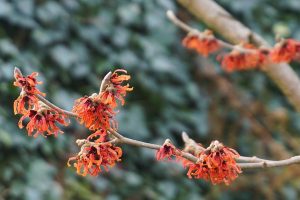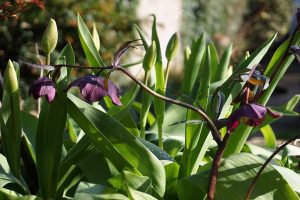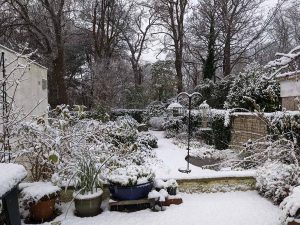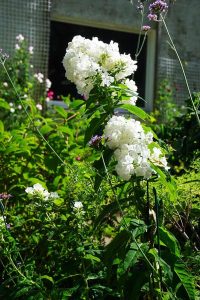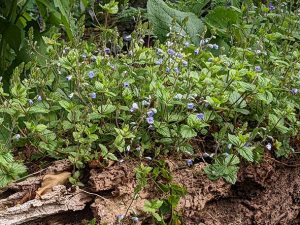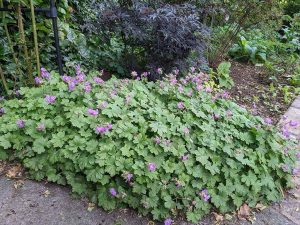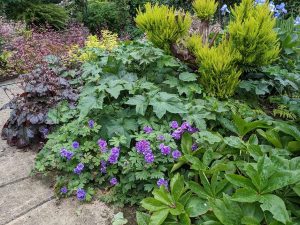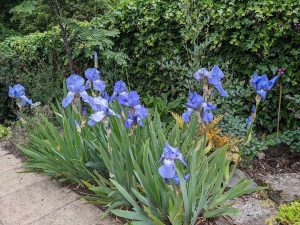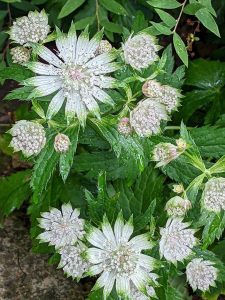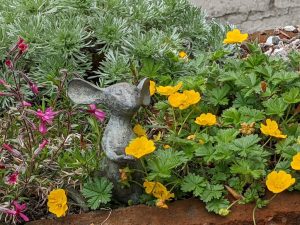Apparently we are not supposed to think of slugs and snails as pests in our garden any more, however, I do think that they can cause so much damage to certain plants that I consider them a bit of a pest in my own garden. Over the years I have tried to only plant slug resistant plants so that I am not constantly being disappointed at the total decimation of my newly acquired plants. Plants cost a lot of money and I take umbrage at them being slug food. I don’t mind the small grey ones which can take the odd nibble or two out of my primulas but it is the huge Arion slugs that can destroy a whole plant in one evening. I know that some slugs are the gardeners friend, such as the green or yellow cellar slug that will eat algae and mould, and the leopard slug that will feed on fungi and rotting vegetation and other slugs. I have tried many methods to control the numbers such as deterrents and barriers like surrounding susceptible plants with a variety of materials such as: crushed egg shells, or wool (or wool pellets), or grit, or sand, or coffee grounds, or bran. None of these worked. The bran is meant to work by the slugs gorging themselves on it and they end up bloated. They are slow to go back into cover so are picked off by predators – so they say (but I haven’t tried this method). I have seen the slugs move across all sorts of surfaces and onto the plant. I have seen slugs moving across a very prickly cactus plant in the conservatory, and up very prickly stems of the moss roses in the stumpery. The sand just gets bounced away with heavy rain, and I have heard that the slugs just produce more slime in order to combat a surface they don’t find comfortable. I did think that the sand would work as it would stick to their slimy bodies but alas they didn’t care. I have tried making up a strong garlic solution to drench the plants as many people find that it works as a deterrent, but it certainly didn’t work on the new shoots of Brunnera ‘Jack Frost’ in the spring, but as the plants grew a bit the leaves became a little less palatable to them. You do have to re-apply after rain as it washes off. I have tried Vaseline on the rims of pots and also up the stalks and around flower bud of narcissi but somehow the slugs and snails still managed to get passed the sticky surface. The copper tape method can work but might only work if you put enough tape around the pot. I just put one inch of copper tape around a large pot and the slug can be seen arching it’s body over the band of tape to reach further up and over. Once I put about 6 inches of tape around the pot the plant has managed to grow on and has had no further damage. This isn’t nice to look at and you have to keep the pot away from any other surface or plant in case the culprit can just stretch across the gap or get a bridge from a leaf of another close by plant. If I had put the tape around the rim it may have helped, but they leaves could overlap the pot edge so the slug would still have been able to get into the plant.
 |
| Slug in astrantia pot
|
|
|
|
|
|
 |
| slug avoiding copper tape |
 |
| astrantia regrowth in pot with more copper tape |
Now and again I have used pellets and also nematodes. I am trying to avoid these as they not only kill the bad slugs but they also kill the good ones. The nematodes are at least environmentally friendly but are a pain to use as you have to have various jugs and buckets to get the correct amount of water to mix the nematode mixture in, the soil has to be a certain temperature and must be fairly wet too. The nematodes are only active for around six weeks and I am not sure if they actually kill snails. They are also quite expensive especially if you have a large garden. Slug pellets, even if they say they are organic, can possibly affect other creatures if they are consumed in large quantities. I have used them in small quantities around specific plants but I don’t think I will again.
The methods I prefer are the slug traps and just going on a slug and snail hunt in the morning and Harry does it at night. The slug traps can be anything like butter containers or jam jars with and inch or two of cheap beer in the bottom. Lee shows you how here. If you dig a small hole in the ground near a susceptible plant and place the jam jar in the hole with about an inch of the jar above soil level. Cover this with a broken bit of pot that is slightly curved so the rain doesn’t get in but the slugs can. With the jar being slightly above soil level means that ground beetles are less likely to fall in. The slugs go in for a feed of sweet beer and fall in and drown (intoxicated?) but the trouble is that again this is indiscriminate. (I use the jam jar and keep the lid so that I can pick the jar out of the hole and screw the lid firmly on so that I can transport it on my lap without spillage, dispose of the slugs and re-use the jar trap.) Both good and bad slugs have a boozy end, and so do some wasps. You can empty them into your compost heap afterwards.
 |
| Jam jar beer trap |
 |
| Jam jar beer trap lid on |
Picking off the bad guys is a good method at controlling the numbers but nature will never leave a void so more slugs and snails will come in. I actually like the presence of snails as the blackbirds and thrushes can have have a good meal. I do throw them into the golf course behind us though and they can takes their chance if they want to come back. The little slugs are food for the frogs, newts and hedgehogs (we have only had one hedgehog visit). If you walk around your garden regularly you will get to know where their favourite hiding places are so you can check them out on a slug hunt. You can even put something they love nearby as bait such as old melon skin, then go and pick them off. One favourite hiding place for snails is in the holes in the wall of the raised bed. You have to be careful sticking your hand in the holes as sometimes wasps and bees can be found there too and you can get stung if not wearing gloves.
I have read various websites to find slug and snail proof plants but I think it is a bit of trial and error to find the ones that will survive in your garden. I have 3 Astrantias in the garden and only the white one was resistant to attack (not completely however). The pink and red ones got totally decimated wherever I sited them. Some websites say that fennel should be ok, and mine was for a few years but there must have been a stack of eggs in the base of one plant and the whole bronze fennel was covered in them. I now don’t bother trying to grow hostas or delphiniums, and even my Salvai Amistad can be a bit hit and miss from attacks. I do love my narcissi so I will keep trying to find a solution to stop the slugs and snails eating the flower heads. So here is a list of plants in my garden that are pretty resistant to slugs and snails. Note that I haven’t added shrubs or annuals to the list, they are mainly perennials.
Slug and
snail resistant plant list (in my garden)
This is a list of the
perennials and bulbs that are slug and snail resistant in my garden (although
some can get nibbled they are not decimated).
·
Ajuga reptans
·
Alchemila mollis
·
Allium bulgaricum
(Nectaroscordum siculum or honey lily)
·
Androsace
lanuginosa wooly rock jasmine
·
Anemones Japanese
and other types
·
Aquilegia
·
Arisarum
proboscoideum mouse plant
·
Artemesia
·
Astilbe
·
Brunnera macrophylla
but NOT Brunnera Jack frost, it can get quite a bit of damage until
leaves are older
·
Calluna (heather)
·
Camassia
leichtlinii
·
Centauria the blue/purple ones are ok but the white
versions are often eaten
·
Cerastium
tomentosum (snow in summer, dusty miller)
·
Chiastophylum
oppositifolium
·
Chionodoxa
·
Cirsium rivulare
Atropurpureum
·
Cistus
parviflorus
·
Corydalis
·
Crocus
·
Cyclamen
·
Dicentra
·
Digitalis
·
Epimedium
·
Erica (heaths)
·
Erigeron karvinskianus
·
Erythronium
mostly ok but some nibbles
·
Ferns
·
Filipendula
ulmaria Meadowsweet
·
Fritillaria
snakes head
·
Galium odoratum
Sweet woodruff
·
Gallanthus
snowdrops
·
Geum
·
Geranium( hardy)
·
Gillenia
trifoliate
·
Grasses
·
Hebe
·
Hedera (most
ivies) although the snails love hiding in it
·
Hellebores (can
be nibbled by snails)
·
Heucheras
·
Hyacinthoides
·
Hydrangea
anomala petiolaris
·
Lamium hybridum
dead-nettle
·
Leptinella
squalida Platt’s black
·
Ligusticum
scoticum
·
Lonicera honey
suckle
·
Myosotis
forget-me-nots
·
Nepeta x faassenii Junior Walker
·
Oregano vulgare
‘Aureum’ golden oregano
·
Oxalis acetosella
wood-sorrel
·
Papaver orientale
Patty’s plum
·
Parahebe porlock
·
Parthenocissus
henryana Chinese Virginia creeper
·
Peony red
·
Persicaria
affinis superba (knotweed)
·
Persicaria amplex
Blackfield
·
Phlox ice cream
·
Polemonium
caeruleum Brise D’anjou Jacob’s ladder
variegated
·
Potentilla
thumberi Monarch’s velvet
·
Pulmonaria ‘Lewis
Palmer’ lungwort
·
Pulsatilla
vulgaris papageno Pasque flower
·
Rodgersia
podophylla
·
Roses
·
Saxifrages
·
Selinum
wallichanum (a few nibbles)
·
Silene dioica red campion
·
Sisyrimchium
californicum brachypus
·
Spirea
·
Thalictrum
flavium Glaucum
·
Tierella
·
Thyme
·
Vancouvera
hexandra
·
Verbascum
·
Verbena
bonariensis
·
Veronica
Gentionoides Blue streak and other veronicas
·
Vinca major and
minor
·
Viola





























